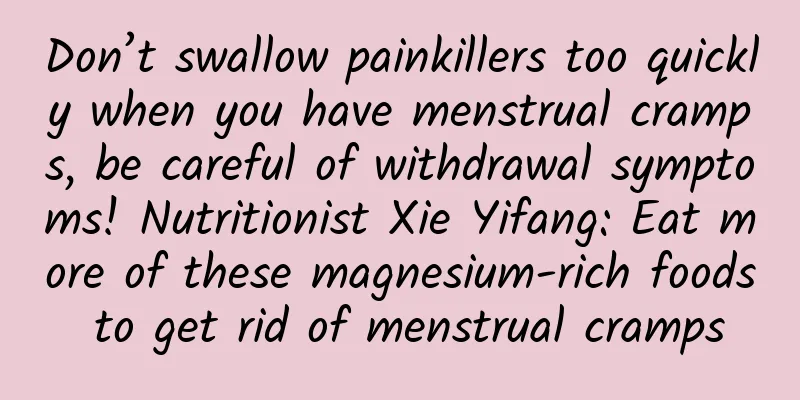Don’t swallow painkillers too quickly when you have menstrual cramps, be careful of withdrawal symptoms! Nutritionist Xie Yifang: Eat more of these magnesium-rich foods to get rid of menstrual cramps

|
Some women roll on the ground due to menstrual pain every month and can only take painkillers to relieve the pain. Nutritionists remind people not to take too many painkillers as they may cause withdrawal problems. Nutritionist Xie Yifang says it is a good idea to supplement and regulate your body with appropriate nutrients, especially foods rich in magnesium. According to relevant research results from abroad, 45% of dysmenorrhea patients have significantly lower magnesium levels in their bodies than normal people. The magnesium content in the body is below the average, which means that you can eat magnesium-rich vegetables, fruits and other foods in moderation to alleviate dysmenorrhea. Menstrual pain is related to magnesium deficiencyMagnesium can activate multiple enzymes in the body, inhibit nerve excitation, maintain the stability of nucleic acid structure, and participate in protein synthesis, muscle contraction and body temperature regulation. In addition, magnesium also affects people's emotions; lack of magnesium in the body may make people's emotions tend to be tense, increase the secretion of tension hormones, and lead to dysmenorrhea. Foods rich in the mineral "magnesium" include: millet, corn, etc.; legumes include soybeans, black beans, broad beans, peas, cowpeas, tofu, etc. To relieve menstrual pain, eat more magnesium-rich foodsFoods rich in the mineral "magnesium" include: millet, corn, etc.; beans include soybeans, black beans, broad beans, peas, cowpeas, tofu, etc.; vegetables include seaweed, snow vegetable, winter vegetables, amaranth, shepherd's purse, mushrooms; fruits and nuts include carambola, longan, peanuts, walnut kernels, etc. Although there is no recommended intake of magnesium in Taiwan's Recommended Daily Nutrient Intake (RDNA), the United States does have a recommended intake of 350 mg to 400 mg per day. If you follow the principle of a balanced diet, this recommended amount is actually not difficult to achieve. In addition to supplementing magnesium, nutritionist Xie Yifang said that during menstrual cramps, you can eat more high-fiber foods, which can promote the excretion of estrogen, increase the magnesium content in the blood, and have the effect of regulating menstruation and calming nerves. Foods including vegetables, fruits and whole grains, such as whole wheat bread, brown rice and oatmeal, all contain more fiber. In addition, you should avoid consuming caffeinated beverages such as coffee and tea to avoid increasing anxiety and uneasiness; you can drink barley tea or mint tea instead. Avoid excessive magnesium intake to relieve menstrual painHowever, it is worth noting that excessive intake of magnesium can also cause poisoning, with symptoms including sluggishness, coma, and damage to the central nervous system. Even when taking magnesium-containing nutritional supplements, you should pay attention to the dosage to avoid suffering harm before reaping the benefits. |
Recommend
Does ovarian cyst cause back pain?
Ovarian cyst is a common gynecological disease. O...
What to do if a 16-year-old has abnormal leucorrhea
Abnormal leucorrhea at the age of 16 may be cause...
How much does it cost to treat hydatidiform mole?
The cost of treating hydatidiform mole is usually...
After exercise, uterine fibroids disappeared
It is not entirely accurate to say that uterine f...
Cure rate of moxibustion for hyperprolactinemia
Hyperprolactinemia (HPRL) refers to a syndrome ca...
Symptoms of cervicitis often occur
Cervicitis is a common gynecological inflammation...
What should you pay attention to before painless abortion? What preparations should you make before painless abortion?
What should you pay attention to before painless ...
What are the examination methods for endometrial tuberculosis?
We all know that endometrial tuberculosis is a co...
What are the causes of uterine fibroids? The causes of uterine fibroids are related to these things
The causes of uterine fibroids are still unclear,...
Where can I cure pelvic peritonitis?
"How to choose a hospital to treat pelvic pe...
There are three possible situations of cervical erosion in women. You should pay attention to these when treating cervical erosion.
Many women get worried when they hear the word &q...
Self-relaxation therapy can relieve the mood of patients with functional uterine bleeding
Patients with functional uterine bleeding often b...
Learn about the examination items for ovarian cysts.
Did you know that ovarian cysts are classified in...
What are the effects of hysterectomy for adenomyosis?
Hysterectomy for adenomyosis can cause women to l...
Reasons for delayed menstruation in women
Reasons for delayed menstruation in women: If a w...









